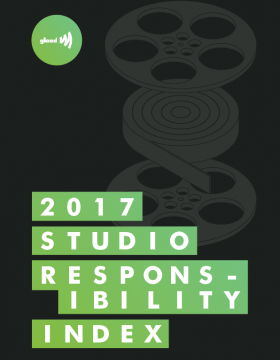25 May2017
2017 GLAAD Studio Responsibility Index...
Oh noooo...!!!
It's that time of the year when GLAAD releases its Studio Responsibility Index...
Sadly, for us...that means we have to trawl through the dross that Hollywood produces...(with the odd exception)...as we sit back, reluctantly ready to watch the likes of...
Mike and Dave Need Wedding Dates, Neighbors 2: Sorority Rising, Dirty Grandpa, Zoolander 2...
...we ask ourselves: Why bother? GLAAD: why bother with this unnecessary report? Especially in the year that a 'gay' film 'won' the Oscar for best picture!
Redundancy...is a word that springs to mind!
Overview of Findings...
- Of the 125 film releases GLAAD counted from the major studios in 2016, 23 (18.4%) contained characters identified as lesbian, gay, bisexual, transgender, or queer. This is an increase of nearly one percentage point from the 17.5% of films (22 of 126) found to be inclusive in 2015.
- Gay men continue to be the most represented by a significant margin with 83% of the inclusive films featuring gay male characters. This is an increase of six percentage points from the previous report (77%). Representation of lesbian characters is up with 35% of inclusive films including lesbians, a significant increase of 12 percentage points from the year before. There was also an increase in bisexual representation: 13% of major studios’ inclusive films counted bi characters compared to 9% in last year’s report. GLAAD counted one transgender-inclusive film (Paramount’s Zoolander 2), similar to the previous report.

- GLAAD tallied 70 LGBTQ characters among all mainstream releases in 2016, up from 47 in 2015. It is important to note that 14 of these characters were part of a single musical number in Universal Pictures’ PopStar: Never Stop Never Stopping, which misleadingly inflated the numbers. Male characters again vastly outnumbered females by two to one (47 to 22), compared to 36 men and 11 women in 2015’s major studio releases. One character (All, Paramount’s Zoolander 2) was counted as non-binary.
- The racial diversity of LGBTQ characters again decreased in films tracked in 2016 after another dramatic drop the year before. In 2016, only 20% were people of color, compared to 25.5% the year before and 32.1% in films released in 2014. Of the 70 LGBTQ characters counted, 48 were white (69%), nine were Black/African American (13%), one was Latinx (1%), and four were Asian/Pacific Islander (6%). Eight characters (11%) were non-human (Disney’s Zootopia, Sony’s The Angry Birds Movie and Sausage Party).
As has been the case each year since GLAAD began this report, comedies remain the most likely major studio films to be LGBTQ-inclusive. Of the 125 films tracked, GLAAD identified 39 films as comedies, of which 12 (31%) were inclusive. By comparison, GLAAD counted 44 films as genre films (action, sci-fi, fantasy/horror), of which six (14%) films were inclusive. Additionally, two of 27 dramas (7%), and three of 15 animated/family films (20%) included LGBTQ characters. GLAAD did not count any documentaries from the major studios in 2016.

- Paramount and Universal Pictures tied as the most inclusive major studios tracked in this year’s report. Five of Paramount’s 15 films (33%) were LGBTQ-inclusive, and Universal’s five of 17 total films equates to 29%. Warner Brothers is next with four of 19 films (21%), followed by 20th Century Fox at three of 16 films (19%), and Lionsgate with three of 24 films (13%). Two of Sony’s 21 films were inclusive (10%), and Disney rounds out the group with one of 13 (8%). In last year’s reporting, both Paramount and Disney were found to completely exclude LGBTQ characters from their slates.
- Download the full publication in PDF format.

